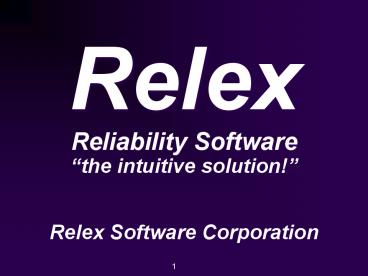Relex Reliability Software - PowerPoint PPT Presentation
1 / 34
Title:
Relex Reliability Software
Description:
Relex Reliability Software the intuitive solution! Relex Software Corporation * What is Relex? A Powerful Reliability Software Tool performs efficient ... – PowerPoint PPT presentation
Number of Views:187
Avg rating:3.0/5.0
Title: Relex Reliability Software
1
RelexReliability Softwarethe intuitive
solution!Relex Software Corporation
1
2
What is Relex?
- A Powerful Reliability Software Tool
- performs efficient reliability analysis
- uses multiple analysis techniques
- provides advanced features
3
Relex Is Uniquely Qualified
- Reliability Engineering Experience
- Commercial
- Military
- Software Development Experience
4
RelexReliability Softwarethe intuitive
solution!Relex Software Corporation
5
- Introduction to Reliability Prediction
6
Reliability Predictions
- What is a Reliability Prediction?
- Calculation of failure rate (MTBF)
- How is it Calculated?
- Based on established reliability model
7
Reliability Measures
- Failure Rate (?)
- Mean Time Between Failures (MTBF)
- Reliability
- Availability
Sample Relex Reliability Prediction calculation
results
8
Failure Rate
- Defined As
- Rate of Occurrence of Failures
- Number of Failure in Specified
- Time Period
- Units
- Failures per Million Hours
- Failures per Billion Hours (FIT Rate)
9
MTBF
- Defined As
- Mean Time Between Failures
- Number of Hours to Pass
- Before a Failure Occurs
- Inverse of Failure Rate
- Units
- Typically expressed in Hours
- Constant Failure Rate Systems
10
Reliability
- Defined As
- The probability that an item will perform a
- required function without failure under
- stated conditions for a stated period of
- time
- Units
- Probability Value (0-1)
11
Availability
- Defined As
- The probability that an item is in an
- operable state at any time
- Units
- Probability Value (0-1)
12
Reliability Summary
- Failure Rate -- number of failures in time
- MTBF -- average time between failures
- Reliability -- takes into account mission time
- Availability -- accounts for repairs (MTTR)
- and downtime
13
The Bathtub Curve and Reliability
14
The Bathtub Curve
- Represents failure rate tendencies for the
lifespan of an item - Failure rate varies in different phases of life
15
Three Phases of Life
- Infant Mortality Region
- Wear-Out Region
- Constant Failure Rate Region
16
Bathtub Curve
- Graph of Failure Rate vs. Time
- Considers three phases of life
- Represents lifespan of item
- (i.e. 15 years for a car)
17
Bathtub CurveIllustration
Infant Mortality
Wear Out
Constant Failure Rate
Failure Rate
Time
17
18
Reliability Models
19
Influences to reliability /Model-parameters
Production factors
Application factors
20
Relex Prediction Models
- MIL-HDBK-217 (FN1, FN2 )
- Telcordia (Telcordia 1, Bellcore 4,5,6)
- Prism RAC model (Process Grades, Bayesian)
- NSWC-98/LE1 mechanical model
- HRD5 British telecomm model
- CNET 93 French telecomm model
- 299B Chinese standard
Relex allows the user to use multiple models
within one project and use functionality across
models (i.e. use Prism process grade factors on
217 predicted failure rates, use Bellcore methods
on 217 calculations, etc.)
21
MIL-HDBK-217
- Original standard for reliability
- Reliability math models electronic devices
- Used commercially in the defense industry
- Currently at Revision F Notice 2
22
Parts Count
- A section of MIL-HDBK-217
- Provides simpler reliability math
- Typical Uses
- Used early in the design process
- Used to acquire a rough estimate of reliability
23
Telcordia (Bellcore)
- Originally developed at ATT Bell Labs
- Modified MIL-HDBK-217 equations
- New equations represented what their equipment
was experiencing in the field
24
Telcordia (Bellcore) (cont.)
- New model with new feature
- Account for real data
- Burn-in, Field, Laboratory testing data
- Popular standard for commercial companies
25
Mechanical
- Based on the Handbook of Reliability Prediction
Procedures for Mechanical Equipment, NSWC-98/LE1 - Provides models for various types of mechanical
devices including springs, bearings, seals, etc. - New and unique standard
26
CNET HRD5
- Used in Europe
- Reliability models for telecommunications
- Current Versions
- HRD - 5
- CNET - 93
27
Bellcore vs. 217
- Recognition Acceptance
- Concentration
- Calculations Equations
- Consideration of Test Data
- Multiplier
- Parts
- Environments
- Quality Levels
28
Accuracy of MTBF Assessments
Stage IParts count method, assuming constant
failure rates Stage IIVariation of failure
rates according to part families Stage
IIITaking into account of operational
parameters Stage IVConsideration of failure
modes, time influences, different failure
distribution for each part, etc.
Accuracy
Time spent for the analysis
29
PRISM Reliability Model
- Developed by the Reliability Analysis Center
(RAC) - Accounts for the effect of process related
variability on system failure rate - Inherent failure rate based on base failure rate
and environmental conditions (RAC Rates model) - Failure rate may then be modified by
- Process Grade Factors, and/or
- Bayesian Analysis, and/or
- Predecessor Data
30
PRISM Methodology
Operational Profile, Environmental and Electrical
Stresses
Process Assessments
RAC ComponentModels
Test Data
RAC Failure Rate Databases
System Reliability Assessment Model
Bayesian Data Combination
Historical Data on Similar Systems
System Reliability Estimate
Software Model
31
Primary Causes of Failure
(Nominal Values)
32
PRISM Process Grade Factor Types
- Design
- Manufacturing
- Parts Quality
- System Management
- CND (Can Not Duplicate)
- Induced
- Wearout
- Growth
- Infant Mortality
33
Other PRISM Adjustments
- Bayesian
- Uses test and field data to enhance predicted
failure rate - Predecessor
- Uses previous history data to further refine
predicted failure rate
34
PRISM Note
- Although PRISM contains RAC Rate models for many
part types, it does not include the following - Rotating devices Relays
- Switching devices Tubes
- Connections Lasers
- Miscellaneous parts
- Relex can solve this problem by allowing the user
to apply PRISM concepts (Process Grade, Bayesian,
Predecessor) to a failure rate calculated by all
other models.































